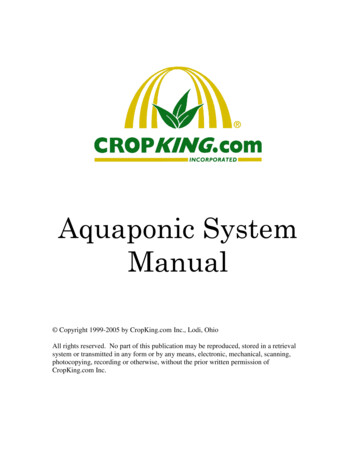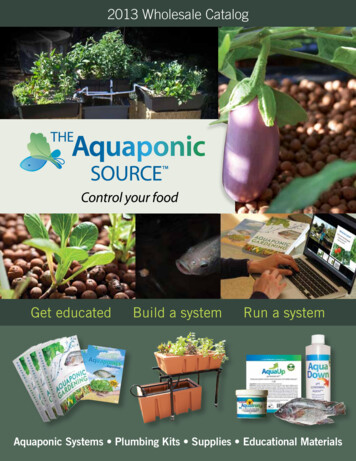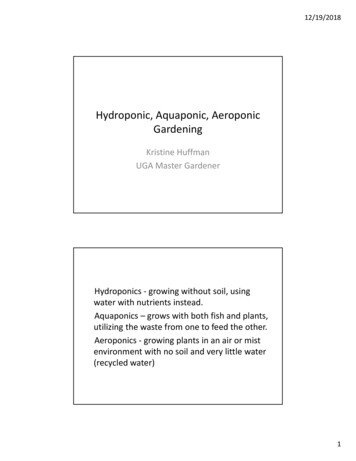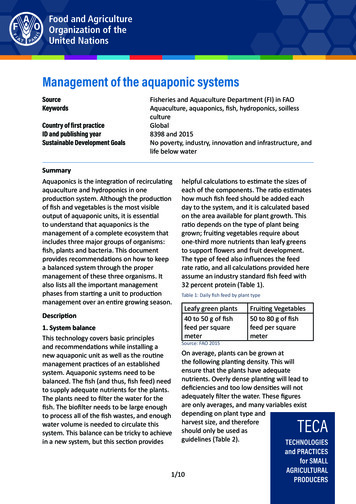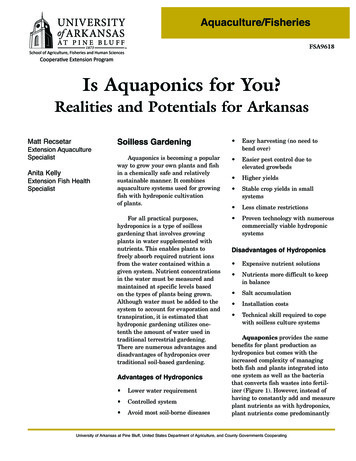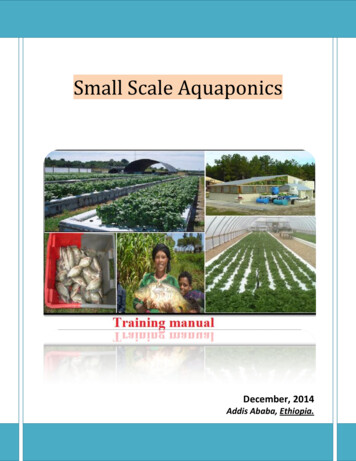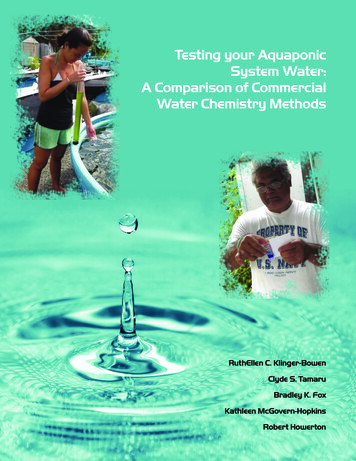
Transcription
Testing your AquaponicSystem Water:A Comparison of CommercialWater Chemistry MethodsRuthEllen C. Klinger-BowenClyde S. TamaruBradley K. FoxKathleen McGovern-HopkinsRobert Howerton
Testing your Aquaponic System Water:A Comparison of CommercialWater Chemistry MethodsRuthEllen C. Klinger-BowenClyde S. TamaruBradley K. FoxKathleen McGovern-HopkinsRobert HowertonCollege of TropicalAgriculture and HumanResourcesMarch, 2011Aquaponics involves the dynamic interaction of fish, plants, bacteria, and their aqueousenvironment. The fish and plants are dependent on the balance of dissolved nutrientsand quality of the water, as they generate and utilize metabolic products from each other.It is this unique balance that leads to healthy animals and a productive crop. Because ofthe symbiotic uptake and release of nutrients from fish to plants, periodic monitoring ofyour aquaponic system water is essential. There are a multitude of commercially available water testing systems ranging from water test strips and kits to electronic meters.Both strips and kits can be obtained at local aquarium shops, while multiparameteraquaculture kits and electronic meters must be mail ordered. The choice(s) of whichmethod to use can be particularly daunting, especially for those who are just starting inaquaponics. Are test strips any good for measuring pH or should I purchase a meter?Do I have to know how much nitrate is in my system and which is the best method tomeasure it? These are typical questions being asked of extension personnel and unfortunately there are no simple answers. Every person will be faced with a different situation (e.g., type and number of systems, beginner, advanced) This publication will helpguide your decision to choose the best method(s) for your needs, and is based uponinformation regarding availability, ease of use, accuracy, precision, and cost.What parameters to test?Prior to obtaining the items for water testing, you should ask yourself the following: What water parameters affect the fish the most? What water parameters affect the plants the most? What water parameters affect the bacteria the most? How much do I want to spend, without compromising how “accurate”I need to be?
Fish Culture:The following water quality parameters are typically of highest importance to freshwater fish being raisedunder aquaculture conditions: Water temperature, which is measured in units of degrees Farenheight (ºF) or Centigrade (ºC). Dissolved oxygen (DO) is the amount of oxygen (O2) dissolved in water and is measured in units ofpercent saturation or parts per million (ppm). pH is a measure of how acidic or basic the water. pH ranges from 1 - 14. A pH of 7 is neutral, belowthat is acidic, above that is basic. Buffering capacity or alkalinity refers to water’s ability to keep the pH stable and is highly dependenton the amount of minerals dissolved in the water. Ammonia is the first product in thenitrogen cycle (Figure 1). In water it existsin two forms and together is known asTotal Ammonia Nitrogen (TAN) andmeasured in units of mg/L or ppm. Thetwo forms of ammonia are unionizedammonia (NH3 or UIA) and ionizedammonia (NH4 ). You should learn thedifferences between the two forms ofammonia because it is the unionizedammonia (UIA) that is most toxic tofish. Which form of ammonia is presentin water is highly dependent on bothtemperature and pH. Nitrite is the second product in theFigure 1. Schematic representation of the nitrogen cycle.nitrogen cycle. Nitrite is a highly toxicsubstance that is produced by the oxidation of ammonia by bacteria. It is converted to the nontoxicform nitrate with biological filtration and measured as total nitrite or nitrite-nitrogen, dependent onthe water chemistry test kit, in units of mg/Liter or parts per million (ppm). Nitrate, the final product in the nitrogen cycle, is usually not measured in an aquaculture setting asit is generally not toxic to freshwater fish and aquaculture test kits often do not carry the reagents tomeasure it.2Testing your Aquaponic System Water: A Comparison of Commercial Water Chemistry Methods
Plant Culture:Sixteen chemical elements are known to be important to a plant’s growth and survival. The sixteenchemical elements are divided into two main groups: non-mineral and mineral. The non-mineral nutrients arehydrogen (H), oxygen (O), & carbon (C) and these nutrients are found in the air and water. In a process calledphotosynthesis, plants use energy from the sun to change carbon dioxide (CO2) and water (H2O) into starchesand sugars. These starches and sugars make up the plant’s food.The 13 mineral nutrients, which normally come from the soil, are dissolved in water and absorbed througha plant’s roots. Not all of the mineral nutrients are routinely measured but are being presented to raise awareness of the essential elements necessary for plant growth. For a modest fee, the full spectrum of mineralsfrom a water sample can be obtained by submitting sample(s) to an agricultural diagnostic service such as theone at the University of Hawaii at Manoa1.In an aquaponic setting, the majority of these mineral nutrients result from byproducts excreted by thefish. These mineral nutrients are divided into two groups: macronutrients and micronutrients. The macronutrients, required in large quantities, are: Nitrogen (N) - part of all living cells and a necessary component of all proteins. Phosphorus (P) - an essential part of the process of photosynthesis and in the formation of all oils,sugars and starches. Potassium (K) - helps in the building of protein, photosynthesis, fruit quality and reduction of diseases. Calcium (Ca) - an essential part of plant cell wall structure and the transport and retention of otherelements. Magnesium (Mg) - part of the chlorophyll in all green plants that is essential for photosynthesis. Sulphur (S) - essential for the production of proteins Micronutrients, essential for plant growth but needed in small (micro) quantities are: Boron (B) - aids in the production of sugar and carbohydrates. Copper (Cu) - important for reproductive growth in plants. Iron (Fe) - essential for formation of chlorophyll. Chloride (Cl) - aids in plant metabolism. Manganese (Mn) - functions with enzyme systems involved in breakdown of carbohydrates, andnitrogen metabolism. Molybdenum (Mo) - helps in the use of nitrogen. Zinc (Zn) - essential for the transformation of sc.aspxRuthEllen Klinger-Bowen, Clyde S. Tamaru, Bradley K. Fox, Kathleen McGovern-Hopkins, Robert Howerton3
In aquaponic systems, the ultimate source of bothmacro and micronutrients is fish food. The consumedfood provides fish with energy and the essential building blocks for growth. The digestion and metabolicprocesses create waste products that are excreted viathe fish’s gills and digestive tract directly into the water.These waste products primarily consist of carbon dioxide and nitrogenous compounds, such as ammonia.In order to sustain a healthy environment, these substances must be removed from the aqueous environment. Most of the carbon dioxide is eliminated throughaeration at the water surface and taken up by plants.The toxic nitrogenous compounds are converted toless toxic compounds via the nitrogen cycle (Figure 1).A group of bacteria known as nitrifiers (e.g.,Nitrosomonas and Nitrobacter) transform toxic ammonia into nitrite and then to nitrate via biochemical oxidation. The less toxic nitrate is the final end productafter completion of biochemical oxidation that plantstake up as fertilizer.The complex inter-relationship between fish,plants and bacteria impact the water chemistry andare major reasons for periodically monitoring them,particularly when things appear “out of kilter”. In anaquaponic setting total nitrate is added to the list ofwater chemistry parameters that are monitored mostfrequently: Water temperature (ºF or ºC) Dissolved oxygen (D.O.) pHBox 1.Both nitrite and nitrate are commonly reported astwo kinds of values (units) with commercial test kits.Some kits measure the total nitrite (NO2) and totalnitrate ions (NO3) while others measure the amount ofnitrogen (N-) in the total nitrite or nitrate. Analogousto how temperature is measured in either degreesFahrenheit or degrees Celsius, one must also be awarehow your test kit measures these two nitrogen products. You can use the following equations to comparebetween the two reporting systems:Nitrite:1 mg/L nitrite-nitrogen (NO2 - N) 3.3 mg/L* nitrite (NO2)Atomic weight of nitrogen (the N in the NO2) 14.01Atomic weight of nitrite (the N and the two O’s thatmake up NO2) 46.01*46.01/14.01 3.3Nitrate:1 mg/L nitrate-nitrogen(NO3 - N) 4.4 mg/L* nitrate (NO3)Atomic weight of nitrogen (the N in the NO3) 14.01Atomic weight of nitrate (the N and the three O’s thatmake up NO3) 62.01* 62.01/14.01 4.4 Total Ammonia-Nitrogen or TAN Total Nitrite (see Box 1) Total Nitrate (see Box 1)Testing Frequency:How often you test your water is also important. Start-up systems (at initial stocking of plants and animals) should betested daily so adjustments can be made as soon as possible (e.g. decrease feeding, increase aeration, water exchange).After the nutrient cycles are relatively balanced (minimum of 4 weeks), weekly monitoring may be appropriate. Record(in pencil) all your readings in a data book or waterproof paper (see Appendix 1 for an example of a record log). Thiswill aid you when fish stop eating, show signs of distress, or your plants look unhealthy; water chemistries may be out ofnormal range for optimal fish or plant health. You will know immediately if your daily regiment needs amending.4Testing your Aquaponic System Water: A Comparison of Commercial Water Chemistry Methods
Comparison of commercial water test kits:The following is a comparison of various commercially available water test kits and electronic meters (Figure 2).Accuracy (ability of a measurement to be correct) and precision (how reliable a value is when measured repeatedly)were determined for each available method and aspect of water quality being tested (Tables 1 - 8). We also determined“ease of use” (Table 9), which included two conditions: 1) whether directions were simple to follow and 2) whether testtime was quick (less than 10 minutes). Lastly, comparison of cost were made based on pricing from a local aquariumstore and mail order items (Tables 10 - 13). It should be noted that an exhaustive search for the best price for each itemtested goes beyond the scope of this handout. However, once a particular testing method has been decided, we recommend comparison “shopping” both locally or via the internet to obtain the most competitive price.Figure 2. Various methods for measuring water quality parametersa) Test stripsb) Aquarium Kitsc) C ommercial aquaculture kit (individual)d) Commercial aquaculture kit (multiparameter)e) I ndividual parameter meterf) Multiparameter meterRuthEllen Klinger-Bowen, Clyde S. Tamaru, Bradley K. Fox, Kathleen McGovern-Hopkins, Robert Howerton5
Method Accuracy:Disclaimer: Mention of any commercial products in this publication does not constitute endorsement of that product.Table 1. Five methods testing pH at three commercial pH standards and an established aquaponics system.MethodTest RangeIncrement4.0 pH7.0 pH10.0 pHAquaponic SystemAccutest strips6.2 - 8.40.2 6.26.8 8.4 6.2Tetra Aquarium kit5.0 - 10.00.556.5 10.05.0Hach Multiparameter kit*4.0 - 10.00.54.06.5104.5LaMotte Multiparameter kit*5.0 - 10.00.5 5.06.510 6.20.00 - 14.000.014.016.959.754.14PINPOINT Electronic meter*part of a nine parameter test kit - drop color methodAll pH test methods performed well for the three standards. Although the strips have a limited range comparedto other methods, the strips measure the range observed in most aquaponics systems. The strips also displayed thesmallest interval unit (0.2 pH unit) compared to other colorimetric tests (0.5 pH unit). The aquarium and aquaculture(Hach and LaMotte ) multiparameter kits were 0.5 pH units lower for the 7.0 standard, but were highly accurate forthe higher pH 10 standard. The electronic meter was consistently the most accurate (Figure 3).Figure 3. Accuracy testing of pH methodspH 4.0 standardpH 7.0 standard9.06.0 5.0 4.0 Accutest StripspH 10.0 standard128.0 10 7.0 Tetra Aquarium Kit Hach Aquaculture Kit LaMotte Aquaculture Kit11 Accutest Strips Tetra Aquarium Kit Hach Aquaculture Kit LaMotte Aquaculture Kit PINPOINT Meter PinPoint MeterTable 2. Five methods testing total ammonia nitrogen (TAN) at three commercial standards and an established aquaponics systemMethodTest Range (ppm)Increment (ppm)1ppm10ppm100ppmAquaponic System0.0 - 6.00.0, 0.25, 0.5, 1.0, 3.0, 6.0000.50Tetra Aquarium kit0.0 - 5.00, 0.25, 1.5, 3.0, 5.01.55 5.00Hach Multiparameter kit*0.0 - 3.00.21.2 3.0 3.01.40.0 - 2.00.0, 0.05, 0.10, 0.25, 0.50,1.0, 1.5, 2.01 2.0 2.00.250.00 - ?0.01110.05101.672.05Accutest stripsLaMotte Multiparameter kit*YSI Electronic meter*part of a nine parameter test kit - drop color methodTotal ammonia nitrogen (TAN) values were also most accurate using the electronic meter. However, the colorimetrictests performed well particularly at the lower TAN readings. The more concentrated standards could not be accuratelymeasured at the higher levels due to the limits on the upper ranges of most colorimetric tests ( 5.0 ppm). Test stripsdid not perform well in determining the appropriate value for any TAN standard (Figure 4).6Testing your Aquaponic System Water: A Comparison of Commercial Water Chemistry Methods
Figure 4. Accuracy testing of TAN methodsTAN 1 ppm standard 2 1 0 Accutest Strips100 ppm standard10 ppm standard0 10 10010 0 1 Tetra Aquarium Kit Hach Aquaculture Kit LaMotte Aquaculture Kit Accutest Strips Tetra Aquarium Kit Hach Aquaculture Kit LaMotte Aquaculture Kit YSI Meter YSI MeterTable 3. Five methods testing total nitrate (NO3) at three commercial standards and an established aquaponics system.MethodTest Range (ppm)Increment (ppm)1ppm10ppm100ppmAquaponic SystemAccutest strips0 - 2000, 20, 40, 80, 20020020020040Tetra Aquarium kit0 - 1000, 12.5, 25, 50, 10012.52510050Hach kit*5 - 505, 10, 20, 35, 5054422044LaMotte kit*0 - 150, 1, 2, 4, 6, 8, 10, 1514466660.00 - 300.000.0119.37122.6620.5YSI Electronic meter*measurements as nitrate-N and converted to total nitrate (see also box 1).Nitrate results were similar to the determination of TAN in that the electronic meter performed best in hitting themark for all of the standards tested. As with the TAN determinations higher (e.g., 50 ppm) total nitrate levels could notbe accurately measured due to the upper limits of the testing methods that were used. It should be noted that the stripswere least accurate for any of the standards tested. The Tetra aquarium kit performed especially well for the higheststandard measured (e.g., 100 ppm) (Figure 5).Figure 5. Accuracy testing of Total Nitrate methods1 ppm standard 1010 ppm standard100 1 Accutest Strips Tetra Aquarium Kit 100 101 Hach Aquaculture Kit100 ppm standard 100 10 0 LaMotte Aquaculture Kit Accutest Strips Tetra Aquarium Kit Hach Aquaculture Kit LaMotte Aquaculture Kit YSI Meter YSI MeterRuthEllen Klinger-Bowen, Clyde S. Tamaru, Bradley K. Fox, Kathleen McGovern-Hopkins, Robert Howerton7
Table 4. Five methods testing dissolved oxygen (DO) of a bucket with an air stone (represents oxygen saturation at sea level) and anestablished aquaponics system.MethodIncrement (ppm)Bucket w/air stone (ppm)Aquaponics system (ppm)2, 5, 8, 11, 148.05.0Hach Multiparameter kit1.094.0LaMotte Multiparameter kit0.28.04.0YSI Electronic meter0.017.484.2PINPOINT Electronic meter0.18.03.8Tetra Aquarium kitThe DO concentration for 100% air saturated water at sea level (our location) is 8.6 mg O2/L. The kits performedon par with the electronic meters, even though the measurement interval is less (0.01 and 0.1 mg/L - meter vs. 0.2 and1.0 mg/L - kits) (Figure 6).Figure 6. Accuracy of Dissolved Oxygen methods (100% air saturated water at sea level 8.6 mg O2/L): 89 7 Tetra Aquarium Kit Hach Aquaculture Kit LaMotte Aquaculture Kit PINPOINT Meter YSI MeterPrecision Testing:Standards of pH, TAN, and total nitrate were tested by five people to determine the reliability of each method foreach water chemistry parameter. Dissolved oxygen was also measured from a bucket aerated by an air stone, representing 100% air saturated water at sea level, and measured by four testers simultaneously.Table 5. pH 7.0 standard measured by five methods.Tester8Accutest stripTetra Hach LaMotte PINPOINT 0 - 6.56.0 - 6.56.56.95 - 7.00average6.86.16.46.56.98Testing your Aquaponic System Water: A Comparison of Commercial Water Chemistry Methods
Table 6. A 1 ppm commercial standard of total ammonia nitrogen (TAN) measured by five methods.TesterAccutest stripTetra Hach LaMotte YSI 50.8850.250.250.500.55range0 - 0.250 - 0.250 - 0.80 - 0.50.53 - 0.880.100.100.360.100.72averageTable 7. A 10 ppm commercial standard of Total nitrate (NO3) measured by five methods.TesterAccutest stripTetra Hach LaMotte YSI 44035446620.5054025224.412.87range40 - 8025 - 3522 - 444.4 - 668.60 - 20.504827402212.62averageTable 8. Dissolved oxygen (DO) measured from an aerated 5 gallon bucket by five methods.TesterTetra Hach LaMotte YSI meterPINPOINT 98.5910.2range89 - 107.9 - 8.48.59 - 9.128.4 - 10.2average898.28.769.4Based on precision alone, the pH measurements were very consistent among testers with all methods. TAN variedamong the testers, but results were generally between two close benchmarks available for each method. Most testerswere agreeable with all nitrate methods with strips, aquarium kit and Hach kit, but inconsistencies arose among ourtesters for the LaMotte kit and electronic meter. Dissolved oxygen levels were consistent with all available methodsamong the testers (see also Figures 7 - 10).RuthEllen Klinger-Bowen, Clyde S. Tamaru, Bradley K. Fox, Kathleen McGovern-Hopkins, Robert Howerton9
Figure 7. Precision testing of pH methods using pH 7.0 standard.Accutest strip Tetra KitHach Kit88 7 7 766LaMotte Kit86PINPOINT Meter887 6 76 Tester #1 Tester #2 Tester #3 Tester #4 Tester #5Figure 8. Precision testing of TAN methods using 1 ppm standard.Accutest stripTetra kit1.0 00101.00.50 1.0 0.5 0YSI MeterLaMotte Kit 1.0 0.5 0.5 Hach Kit 1.00.50 Tester #1 Tester #2 Tester #3 Tester #4 Tester #5Testing your Aquaponic System Water: A Comparison of Commercial Water Chemistry Methods
Figure 9. Precision testing of Nitrate methods using 10 ppm standard.Accutest stripsTetra Kit 100 10101000YSI Meter 100100 101 1001LaMotte Kit 101Hach Kit110 Tester #1 Tester #2 Tester #3 Tester #4 Tester #5Figure 10. Precision testing of Dissolved Oxygen methods using an aerated 5 gallon bucket.(100% air saturated water at sea level 8.6 mg O2/L)Tetra KitHach Kit 10 9 10 109988PINPOINT Meter81098 LaMotte KitYSI Meter 10 98 Tester #1 Tester #2 Tester #3 Tester #4RuthEllen Klinger-Bowen, Clyde S. Tamaru, Bradley K. Fox, Kathleen McGovern-Hopkins, Robert Howerton11
Ease of use:Table 9. Tests were ranked as easy, fair, or difficult with regard to their use.Easy simple directions, less than ten minutes to record result; Fair simple to moderate study of directions, with ten or moreminutes to record; Difficult directions hard to understand, and/or more than ten minutes for test result.MethodpHTANNitrateDissolved OxygenAccutest stripsEasyEasyEasyn/aTetra Aquarium kitEasyFairFairEasyHach Multiparameter kit*EasyFairFairFairLaMotte Multiparameter kit*EasyFairFairDifficultYSI Electronic metern/aEasyEasyEasyPINPOINT Electronic meterEasyn/an/aEasyWith regard to ease of use, the Accutest strips was found to be the easiest to use. The electronic meters wereeasy to use once they were calibrated. Meters need to be calibrated before each use unless they are used daily, in whichcase weekly calibration is sufficient. Because of the required calibration of each water chemistry value, meters requiremore time initially to understand the directions found in their respective manuals. A varied response ranging from easyto fair was obtained for the multiparameter kits, where following directions were relatively easy, but the time requiredto obtain the results exceeded ten minutes (but less than 25 minutes). The LaMotte kit received a difficult rating withregard to measuring dissolved oxygen due to the multiple chemicals needed for testing. Some testers remarked theyneeded to repeat this test as they were unfamiliar with the kit and became confused by the instructions.Cost:Table 10. Cost of each pH method by purchase price and price per test.MethodNumber of testsCost**Price/testAccutest strips25 16 0.64Tetra Aquarium kit50 8 0.16Hach Multiparameter kit300 266 0.89aHach individual kit300 62 0.21LaMotte Multiparameter kit50 235 4.70aLaMotte individual kit50 45 0.90PINPOINT Electronic meter100 99 0.99200 99 0.50500 99 0.20700 99 0.14**Cost does not include shipping, handling, or hazardous materials charges.a Cost is based on the individual test purchased with a multiparameter kit.12Testing your Aquaponic System Water: A Comparison of Commercial Water Chemistry Methods
Table 11. Cost of each TAN method by purchase price and price per test.MethodNumber of testsCost**Price/testAccutest strips25 13 0.52Tetra Aquarium kit25 17 0.68Hach Multiparameter kit300 266 0.89aHach individual kit300 68 0.23LaMotte Multiparameter kit50 235 4.70aLaMotte individual kit50 67 1.34YSI Electronic meter100 1,000 10.00200 1,000 5.00500 1,000 2.00700 1,000 1.43Table 12. Cost of each NO3 method by purchase price and price per test.MethodNumber of testsCost**Price/testAccutest strips25 16 0.64Tetra Aquarium kit25 20 0.80Hach individual kit50 22 0.44LaMotte individual kit40 52 1.30YSI Electronic meter100 1,000 10.00200 1,000 5.00500 1,000 2.00700 1,000 1.43Table 13. Cost of each DO method by purchase price and price per test.MethodNumber of testsCost**Price/testAccutest stripsn/aTetra Aquarium kit30 8.00 0.27Hach Multiparameter kit100 266 2.66aHach individual kit100 68 0.68LaMotte Multiparameter kit50 235 4.70aLaMotte individual kit50 50 1.00YSI Electronic meter100 1,000 10.00200 1,000 5.00500 1,000 2.00700 1,000 1.43100 99 0.99200 99 0.50500 99 0.20700 99 0.14PINPOINT Electronic meter**Cost does not include shipping, handling, or hazardous materials charges.a Cost is based on the individual test purchased with a multiparameter kit.RuthEllen Klinger-Bowen, Clyde S. Tamaru, Bradley K. Fox, Kathleen McGovern-Hopkins, Robert Howerton13
The local aquarium store’s kit was the lowest in cost per pH test, but individual mail order kits at one company(Hach ) for the other water chemistry parameters earned a greater cost savings. Additionally, if you factor in the ninedifferent parameters the multiparameter kits offer, the price of an individual test decreases considerably. Shipping andhandling as well as possible hazard charges were not factored in for the mail orders, which would drive the price higherthan locally available colorimetric kits. Meters only become cost effective if you have to regularly monitor water quality(e.g. 700 times). Therefore, when looking for a water chemistry method based on cost alone, factor in:1. ) the number of tests it can do2. ) the number you will be doing within the life of the method3. ) shipping/handling charges4. ) possible hazardous (i.e., HAZMAT) chargesWhat’s the bottom line?What water test kit you need for your aquaponics system depends on how many systems you are testing, how accurate you want to be, and how much money you want to spend. Strips were easy to use and moderately priced based ona cost per measurement. It should also be noted that with the exception of the electronic meters, the strips also had thehighest upper limits for TAN and Nitrate. Unfortunately, the strips were also found to be highly inaccurate.The local aquarium kit methodology varied in accuracy, range, ease of use, and cost. The other kits, both individualand multiparameter, were limited in their ability to measure in the higher ranges and typically took 20 minutes for thecolor to develop. But if time is not an issue and you can dilute your sample (e.g. one part sample to four parts distilledwater would be a 1 to 5 dilution; multiply your result by 5), these kits could be cost effective. Also, since nitrate is not athreat to fish in aquaculture settings, it is not part of the commercial multiparameter aquaculture kits. Nitrate test kitsmust be purchased separately.The electronic meters are very accurate but also the most costly, becoming only cost effective when many samplesneed to be routinely measured (research or commercial settings). It also requires greater degree of maintenance andcare (i.e., probes need special care and calibration standards must be purchased and properly stored).For most backyard systems, the aquarium test kits appear to be adequate for most of your needs. However, if yourparameters exceed the higher ranges, you will need to dilute your test sample to determine 1) how high that parameteris, and 2) if you need to rectify the situation immediately (i.e., make a water change). If you are testing multiple parameters periodically (weekly at a minimum), the multiparameter kits available by mail order are convenient, accurate, andcost effective. The electronic meters are “top-of-the-line” in accuracy and many are equipped with an array of probesunder one meter. If you operate a commercial-scale grade aquaponics system(s) or in need of assessing parameters ina large number of settings or in frequency, a meter may be your preferred choice. All the kits and meters are chemistrydriven, which means they need to be properly stored. Use them within the expiration dates and store them as each kitdirects for optimum usage. Whatever method you decide to use, following the storage procedures and directions willextend the life of your water chemistry monitoring system.ReferencesKratky, B.A, 2002. A simple hydroponic growing kit for short term growing vegetables. Cooperative Extension Service,College of Tropical Agriculture and Human Resources. Home Garden, June 2002 dsc/price list.pdf14Testing your Aquaponic System Water: A Comparison of Commercial Water Chemistry Methods
Addresses of Testing ManufacturersAccutest strips andHach KitsHach CompanyP.O. Box 389Loveland, Colorado80539-0389Phone: 800-227-4224Fax: 970-669-2932www.hach.comLaMotte Company802 Washington AvenuePO Box 329Chestertown, Maryland21620 USAPhone: 800.344.3100Fax: 410.778.6394www.lamotte.comTetra Headquarters3001 Commerce StBlacksburg, VA,24060-6671Tel:.540.951.5400www.tetra.netYSI Incorporated, World Headquarters1700/1725 Brannum LaneYellow Springs, Ohio45387-1107 USATel:800-765-4974Fax: 937-767-9353www.ysi.comPINPOINT MetersAmerican Marine Inc.54 Danbury Rd. Suite 172Ridgefield, CT 06877 USATel: 914.763.5367Fax: ntsThe authors extend a hearty MAHALO to the following contributors to the completion of this technical handout: United States Department of Agriculture (USDA) Center for Tropical and SubtropicalAquaculture (CTSA) through Grant No. 2008-38500-19435. University of Hawaii Sea Grant College Program through the United States Department ofCommerce National Oceanic and Atmospheric Administration (NOAA) Project No. A/AS-1as part of the University of Hawaii School of Ocean Earth Science and Technology (SOEST)Sea Grant College Program UNIHI-SEAGRANT-TT-10-04, under Institutional Grant No.NA09OAR4170060. College of Tropical Agriculture and Human Resources (CTAHR), University of Hawai‘i at Mänoa,under Agreement no. 58-5320-8-392 (Amendment 01 and 02) with USDA-ARS, and also supported by Smith-Lever funding. Department of Commerce, NOAA: Sustainable Aquaculture for Food Security in Hawaii: Surveyand Improvement of Farm Production and Post Harvest Practices for Biosecurity and FoodSafety. Award No. 59379. Office Economic Development, County of Maui, Maui County Aquaculture Extension ProgramAward Nos. G2880 and G3210.The authors would also like to express their appreciation to Todd Low and Dr. Allen Riggs of the State Departmentof Agriculture, Agriculture and Livestock Support Services for their support. Photo credits belong to Dr. ClydeTamaru, and RuthEllen Klinger-Bowen. Cover Photo Credits: Marissa Lee (top left) CTAHR, Department of MolecularBiosciences and Bioengineering and Gordon Miyashiro (bottom right), background photo, Dreamstime.com.DisclaimerThe views expressed herein are those of the authors and do not necessarily reflect the views of CTSA, USDA, NOAAor any of its sub-agencies. Mention or display of a company name or product is not a recommendation of that company or product to the exclusion of others that may also be suitable.RuthEllen Klinger-Bowen, Clyde S. Tamaru, Bradley K. Fox, Kathleen McGovern-Hopkins, Robert Howerton15
APPENDIXAppendix 1. Example of water chemistry data ng your Aquaponic System Water: A Comparison of Commercial Water Chemistry Methods
For more information, please contact theCenter for Tropical and Subtropical he Oceanic Institute41-202 Kalanianaole Hwy.Waimanalo, HI 96795U
Five methods testing pH at three commercial pH standards and an established aquaponics system. Method Test Range Increment 4.0 pH 7.0 pH 10.0 pH Aquaponic System Accutest strips 6.2 - 8.4 0.2 6.2 6.8 8.4
